The world is bursting with new ideas nowadays including designing your own radiators and even radiators which look like mirrors. Take a look at the information below to make your home a very exiting place to be.
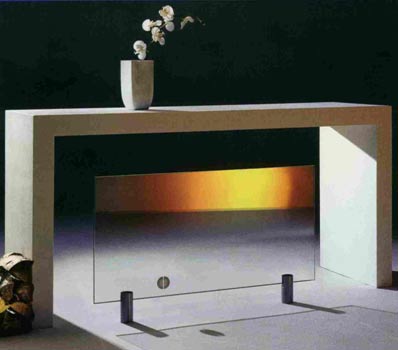
A stylish glass radiator
What is a Glass Radiator?
They are essentially electric radiators, which work is a similar was to a heated windscreen in a car. There is an electrical element built into the glass which heats it up when it is turned on. The glass is toughened safety glass, typically 13mm thick.
They are mounted on walls or directly onto the floor and come in a range of sizes. You can get ones that are plugged in to a normal socket or ones that you will have to wire in to the mains. Please note that for glass towel rails which are fitted into bathrooms will need to comply with Part P regulations. Find out more about the Part P regulations here.
How Glass Radiators and Towel Rails Work
The heat is created with an electric conductive layer on the front of the glass within the lamination. Electricity is sent through this layer, generating heat because of the resistance that the electricity has to work against.
The heat is emitted through infrared radiation. Infrared radiation, also known as thermal radiation, is a kind of energy transportation through electromagnetic waves. Infrared radiation heats up the objects which are hit independently of the ambient air. The best example for this principle is the infrared radiation of the sun, which, similar to the glass radiator, is absorbed by all objects, leading to their warming.
The heat that is generated is then circulated around the room through convection. Convection, in this context, describes the heating up of the ambient air. The warm air ascends because of its tower density and thereby pushes the cooler air towards the ground. This cooler air is then heated up by the heater or radiator and ascends, creating a circular motion of the air that then ensures that it is continually heated.
The circulation of air can create a ″cold feet effect″ as the cooler air is always pushed towards the bottom of a room.
Does the Radiator Create any Electromagnetic Pollution?
EMF’s, or electromagnetic fields are a hot topic of discussion between many health professionals and there are many opinions as to how these fields affect our health.
With the ever-increasing amount of wireless technology available and the numerous health studies linking this to a range of detrimental health issues it is important that we all consider what we bring into our homes and what effect each item could have.
In most cases the magnetic field created by a glass radiator is less than the field created by a normal electric light bulb, but this could depend on manufacturer, so ensure that you check.
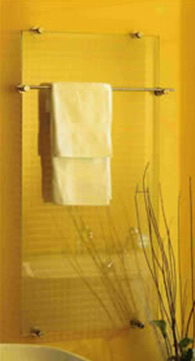
A glass towel rail
Benefits of Glass Radiators and Towel Rails
Imagine you could reinvent the radiator. What about if you could make a radiator become a real work of art, (even design your own) while giving outstanding warmth and efficiency. Perfect in any setting where you want to make an impact, whether it is at home or in the office, glass radiators and towel rails can really "finish" a room. With clear, printed and mirrored versions to choose from you will easily find the ideal radiator for you.
They are some significant benefits:
- Low installation costs – The installation costs of the glass radiator systems are extremely low compared to conventional heating systems. The costs are merely your own, since you do not need a professional to install it for you. They are an excellent choice where you have problems fitting conventional radiators or cannot get pipe-work
- No maintenance costs – Glass radiators incur no maintenance costs whatsoever, unlike many other glass or oil-based heating systems. The glass radiator itself has no working parts of any kind, which normally would need servicing with time
- Easy to relocate – They are not part of a complete heating system so are very flexible and quick to install or move if needed. You can take your complete glass heating system with you when you move house. The ideal room heating system can move with you, without any additional costs
- Low purchase price – The purchase price of the heating system is low compared to conventional gas or oil-based central heating systems
- Wide Range of Choice – Glass radiator and towel rail models vary; some have controllable heating setting or non-controllable, some just plug into existing electrical socket while others are wired. They all tend to have slimline control boxes and are very thin. They can be floor mounted or wall mounted which all means that they can be placed where other heating solutions cannot
- Combinable with renewable energy sources – Renewable energy sources, such as photovoltaic’s or wind power, combined with the ideal efficiency of glass radiators, make it an environmentally friendly alternative to existing heating systems. You’ll also benefit from lower energy consumption costs
- Optimal energy use – Glass radiators do not waste any energy unnecessarily; all the heat is delivered into the room and no heat is lost in pipe-work around your home and there is no need for flues where heat will be lost. The radiator uses the exact amount of energy required to reach the desired room temperature. Different heating programs ensure that the system is only running when you need it, thus saving a lot of energy
- No fuel storage – With glass radiators there’s no need to store fuel, such as oil or wood, at your inconvenience and risk (average oil tank manufacturer guarantee: two years)
Of Course, they are very contemporary in design, which attracts people to them in the first place. The clear glass with no wires or moving parts is what seems to attract people to them; they look fantastic in the right setting.
Disadvantages of Glass Radiators
While glass radiators are a cheap and cost effective method of heating a small room or toping up the heating in a specific part of the home, they can be expensive to run. Electricity has a much higher cost per kilowatt hour of heat produced than other forms of heating.
Glass radiators are nigh on 100% efficient as all the energy that they produce is transferred into the room, so this calculation needs to be done carefully. A great place to start you calculations is to use a calculator to see the amount of heat your room with require, you can find one here.
Glass radiators can be expensive. If you want something tailor made for you and unique, they will be much more expensive.
Controllable versus Non-Controllable Glass Radiators
The non-controllable radiators are set to a temperature at the factory and are either on or off and run at 65° which is the same as a normal household radiator.
The controllable radiators work off a temperature controller which would be situated in a room and the temperature required for the room would be set on the controller. The controller can operate up to 50 radiators in one area and up to around 20 meters away.
Patterned Glass Radiators and Printing on Glass Radiators
Screen print designs on radiators
There is now a really wide range of designs available for glass radiators so it is worth shopping around to get a design that you like.
Personalised designs for your glass radiators are possible for bigger quantities (depending on design, size and quantity) from some suppliers and manufactures. The manufacturer can provide more detailed information on demand.
Design your Own Radiator
It’s true – You can design your own glass radiators and then plumb them in! These glass radiators are designed to be easily fitted into your existing central heating system.
There are several ranges of ArtGlass radiator to chose from but if you cannot find a design you like you can simply design your own. Just provide an image and your very own radiator will be made for you. The front panels for ArtGlass radiators are removable so you can have a different design every week.
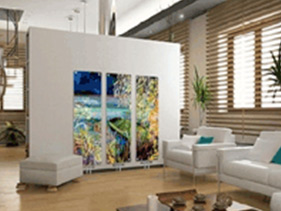
Glass radiators you can design yourself – GlassArt
ArtGlass radiators can be used to match any existing decoration and can easily be used as the focal centre of any room.
Glass Radiator or Towel Rail Energy Consumption
All products will vary, so it is important to read the specifications of the particular radiator or towel rail before you purchase it. This is the energy consumption for a range of typical glass radiators for you to get a feel for what is normal. When in continuous operation for one hour, the electric energy consumption on the highest output level is:
| Size | Max Power | Energy Consumption |
| 600 x 400mm | 240W | 0,24kWh |
| 1000 x 500mm | 500W | 0,50kWh |
| 1200 x 600mm | 720W | 0.72kWh |
| 1500 x 700mm | 1050W | l,05kWh |
Safety Consideration with Glass Radiators
One of the major concerns is, "Can I get an electric shock if the glass breaks?" – The short answer is No. The glass panes are held together through the PVB foil between the panes even if the glass breaks. Furthermore the breakage cuts off the conductive layer on the glass and thereby the electric circuit.
Another serious concern is whether the glass is resistant to breakage. Glass Radiators are made of toughened glass. If you are worried all products should have undergone independent testing, which you should ask to see. They should be able to pass a pendulum test according to DIN EN 12600 up to a pendulum height of 700mm ideally. We still recommend sitting them in a sensible location where they are not likely to suffer serious impact.
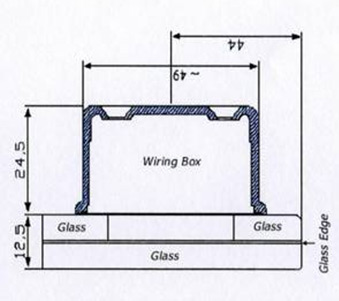
Thermovtt Elegance Model 12/06 Glass Edge showing the control box fitted behind the glass
For safety reasons the typical thickness for slim line glass radiators is around 13mm because they are produced from 2 x 6mm semi-tempered glass. Lower thicknesses are possible from some manufactures, although this would most likely be on a bespoke basis, which will become more expensive; They are not part of the standard product range.
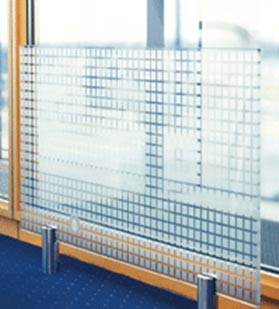
Glass radiator with custom printed design
The warranty period for a glass radiator or towel rails should last for a period of two years after the day of purchase, and for some products longer. Detailed information should be provided by the manufacturer, and it is worth checking this prior to purchase.
Glass radiators will automatically shut off when they reach the desired temperature. Those that are controlled, can be done so in connection with the remote control thermostat. The thermostat measures the actual room temperature and compares it with the desired room temperature programmed in. The smaller the less of a difference between the desired and actual temperature, the less output the radiator will produce. When the room temperature reaches the desired temperature the output level is set to zero.
Do not cover your glass radiator unless, of course, the manufacturer specifically states that you can. But what does happens if the radiator is covered during operation? Beneath the covered part, the heat accumulates leading to a local temperature peak. We recommend that you choose a radiator with a number of safety features to address these issues:
- A temperature sensor can measure the surface temperature of the glass and this will trigger an electronic switch to shut off the radiator as soon as the surface temperature rises above 65°
- Another method, that is often used in conjunction with the method above, is a bimetal spring and this cuts off the electric circuit as soon as 100° (or similar temperature) is reached.
If you are wanting to use a glass radiator for drying purposes such as drying towels etc…. then you should really opt for a towel rail.
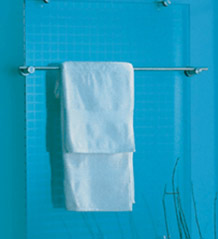
Glass radiator covered by towel rail
Fitting Glass Radiators and Towel Rails
Most manufactures supply mounting brackets or fixings for their glass radiators. These can be for either mounting the radiator on the wall or fixing it to the floor. They come in a range of styles to suit you. Have a look at the examples below:
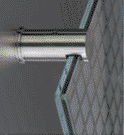
Stainless steel top fixing
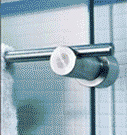
Stainless steel under fixing
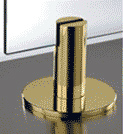
Brass effect floor fixing
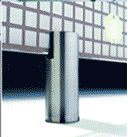
Stainless steel floor fixing
When mounting to the wall, there will typically be four fixing points; two at the top and two at the bottom. There are usually only two fixing points for a floor mounted glass radiator, unless it is particularly large.
Often, most glass radiators are designed to be plugged into a nearby socket, this is the most simple form of installation while others need to be wired in.
This is almost certainly the case when fitting a glass towel rail, as installation will take place within a bathroom and to comply with the previously mentioned Part P regulations, this will need to be the case. Due to this you will need to get an electrician to connect them up.

